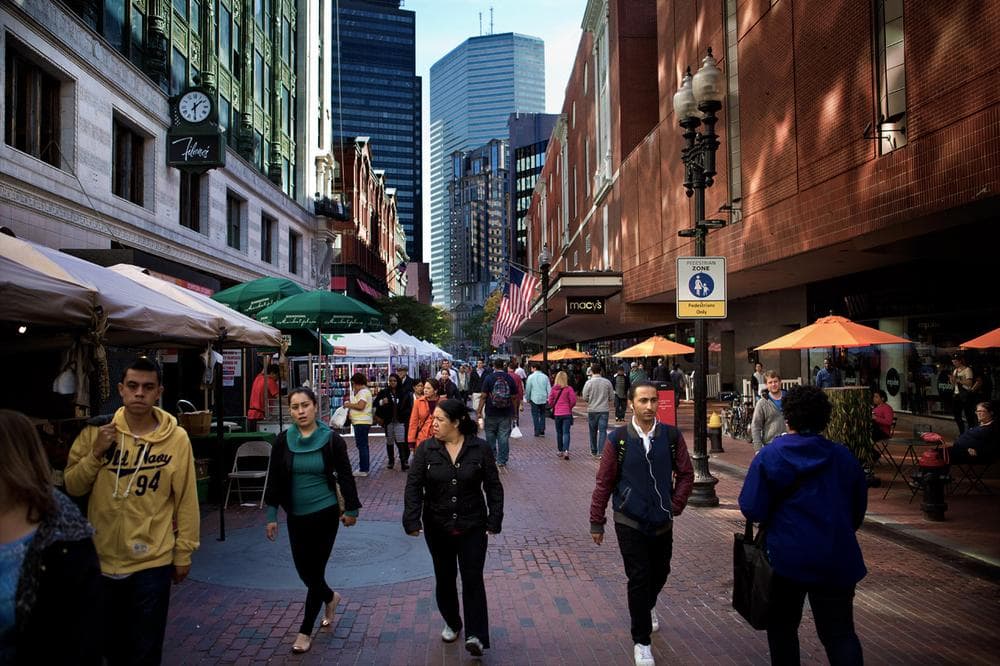Advertisement
In Dense Cities Like Boston, Coronavirus Epidemics Last Longer, Northeastern Study Finds

An analysis by Northeastern University researchers and colleagues finds that in crowded cities — like Boston — coronavirus epidemics not only grow bigger, they also tend to last longer.
The paper, based on data from Italy and China, looks at how quickly an epidemic peaks depending on how crowded a location is.
"In urban areas, we tend to see long, broad epidemics — for example, Boston," says lead co-author Samuel Scarpino from the Network Science Institute at Northeastern. "And in comparatively more suburban or rural areas we tend to see sharp, quick, burst-y epidemics."
Scarpino says it’s key for Massachusetts to have uniform rules across the state, because movement from one area to another — say, from a town where restaurants are closed to one where they’re open — can help spread the virus. Here are some edited excerpts of our conversation, beginning with how he sums up the research just out in the journal Nature Medicine:
Scarpino: What we report in the paper is that the structure of communities affects both the height and the duration of COVID-19 epidemics.
Carey Goldberg: So more dense areas will have not just more cases, but a more prolonged course?
Right. In urban areas, we're likely to have larger outbreaks — in terms of total number, even in terms of percentage of the population — and they will be much longer, lasting weeks and weeks or months, as we've seen in Boston, New York City, London and many places around the world.
However, in rural areas, or areas that have population structures that are much more tightly knit — as opposed to a looser collection of households in neighborhoods, as we have spread out across Boston — you get sharp, intense outbreaks. They can be overwhelming in terms of the resources available for caring for patients, and quite dramatic in terms of their effects on the population.
Think about the outbreak in rural Maine that was sparked by a super-spreading event at a wedding, and how it quickly swept through the population.
Why do these insights about community structure and its effect on transmission matter?
In many rural areas that are at risk of these intense outbreaks, there's much lower health care coverage and often, especially in the United States, a lot more complacency around mask-wearing and physical distancing. These areas are largely protected because they're isolated. However, if cases show up — as we've seen in places like rural Maine — the outbreaks can be quite severe and rapid.
Also, in the more dense areas, you're going to have cases that move around throughout the population, throughout the different neighborhoods of the city. You're going to have outbreaks go quiet in some areas, and then become louder in other areas.
And this process can be very, very prolonged, and can make the types of intervention measures that you need to deploy either quite severe or quite complicated, because they have to be very specifically tailored to what's happening at the really local level within the larger cities.
So what does this mean for policy?
Well, in related work we show that having policies that are different across a city can lead people to move out of their neighborhoods, to go to parks or to go to restaurants with different dining restrictions, or to go to venues with different limits on capacity. And that interacts with the structure of the city to spread the outbreak much more rapidly, kind of accelerating the pace and tempo of cases.
So that really suggests that because the outbreak is going to be so long-lasting, you really either need to focus on driving it completely out or you need to have policies that will protect all of the places with lower rates of cases while intervening in a targeted way in the places with much higher rates of cases.
So what you don't want to do is put in tougher measures in hot-spots, because then you're just going to drive people out to other places where they're going to spread it even more.
Exactly. In the state of Massachusetts, where we have the governor relaxing measures in a fairly extreme fashion in some areas and not in other areas, you are likely to have a situation where you're just moving the infection around and putting other communities at risk.
So having a more intermediate level of control that's more uniformly distributed across space is much better epidemiologically.
But that's not what the state is doing.
The state in many ways is really doing almost the opposite of what our paper suggests in terms of the ways in which you need to focus on controlling COVID-19, and also related work that shows this sort of patchwork of different policies really creates quite a bit of risk.
It seems incredibly important to have hyper-local information, because in the structure you describe, the spread happens at the level of households or neighborhoods, and then you have just a bit of crossover to other places, and that's how it just keeps going.
That is the implication of our work and many other studies that show that COVID-19, from an epidemiological perspective, is an amalgamation of local transmission that's happening in households, in restaurants, in occasional longer-distance transmission that moves it into new areas. So you need to have really hyper-localized information around where the cases are occurring and to find out where the cases are coming from.
And that, unfortunately, is one of the things that we're still not getting clear guidance on from the state: Where are the cases coming from? So that we can understand how we need to intervene.
Without that data, we really aren't armed with the right kinds of information to both stop the spread and to try and implement measures that will maximally control COVID-19 while having the least possible effects on our economic health, mental health and societal health.
